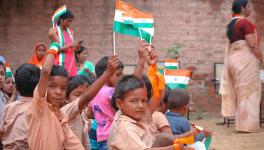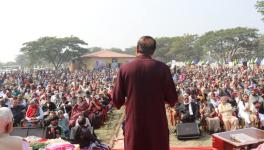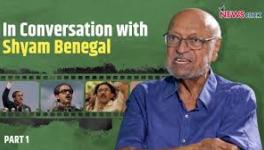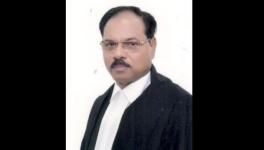Gandhi’s Assassination Was Much More Than Just a Murder
File Photo : Modi - India's New Mahatma
It is far too early to dismiss the possibility of a future Hindu State in India. However, the possibility does not appear a strong one. The secular state has far more than an even chance of survival in India”
(India as Secular State, 1963).
It was the early sixties when American political scientist Donald Eugene Smith commented about the “possibility of a Hindu state in India”.
Today, even to a layperson, the secular state in India seems to be standing on very weak foundations, and the possibility of a Hindu State is far stronger than it was more than half a century ago, in 1963.
Perhaps, a pertinent expression of this transformation of India is the metamorphosis we witness in the image of Nathuram Godse – the assassin of Mahatma Gandhi -- and the growing trivialisation of his most despicable act for which he and his accomplice Narayan Apte were sent to gallows. (November 15, 1949)
No doubt the act itself was the first terrorist act in independent India but was it just that or much, much more.
As Teesta Setalvad writes in the introduction of the book, Beyond Doubt: A Dossier on Gandhi’s Assassination ( Tulika, 2015, Page 1), the act
‘[w]as a declaration of war and a statement of intent. To those forces, who ..., conspired in the killing, the act declared a lasting commitment to India as a Hindu Rashtra, and announced how the RSS and its affiliates would be at perpetual war with the secular, democratic Indian state as well as any and all who stood to affirm these priniciples.’
On closer scrutiny, the assassination could be said to be a culmination of a vicious campaign launched by Hindu communal groups in post-independence times.
There is enough documentary proof available that shows how these Hindu communal groups were attempting direct provocation of ‘organised’ communal violence. B S Moonje, a Hindu Mahasabha leader, who was also one of the founders of Rashtriya Swayamsevak Sangh (RSS), had observed that to counter Jinnah ‘we will have to organise violence on a scientific basis’. He said this in his presidential address to the All India Hindu Mahajati Sammelan (All India Hindu Mahasabha Papers, File C-105/46, Nehru Memorial Museum and Library, quoted in the book, RSS, School Textbooks and Mahatma Gandhi’s Assassination, edited by Aditya and Mridula Mukherjee and Sucheta Mahajan, Page 60)
Perhaps an extract from the same book (page 65) is worth quoting in full to know to what extent they were ready to go.
Hindu Mahasabha workers publicly charged the national leaders with betraying the interests of the Hindus. They threatened that Nehru, Patel and Azad would be hanged and Gandhi Murdabad (Death to Gandhi) became a common slogan at Mahasabha meetings. Delhi Police Abstract of Intelligence dated 18 December 1947 reported an annual rally of the RSS attended by 50,000 volunteers, where Golwalkar described the attitude of the government as ‘unIndian and Satanic’. At a meeting of 2,500 workers on 8 December 1947 Golwalkar said: (Kapur Commission Report, Chapter XIX: 66)
Senior journalist Bharat Bhushan had in a write-up provided details of Delhi CID's report that corroborates this. It spoke of how 'RSS chief Golwalkar threatened to kill Gandhi. The article also includes details of Lucknow CID's letter which spoke of how on December 1, fifty RSS men met in Mathura, and allegedly discussed assassinating Congress leaders.
How did the killers of Gandhi tried [try] to rationalise their criminal act?
The oft repeated explanation about Godse's act talks about his 'spontaneous reaction to Gandhiji's fast to compel the Government of India to release an amount of Rs 55 crores due to Pakistan'. This is a complete lie, because it does not explain why since the mid-thirties, Hindutva Supremacists hatched one plan after other to kill Gandhi and Godse himself was party to two earlier such attempts.
One can as well refer to Chunibhai Vaidya, the legendary Gandhian leader, who wrote in his book:
"Beginning with the year 1934 and over a period of fourteen years, on as many as six occasions, attempts were made to kill Gandhiji. The last one by Godse on January 30, 1948 was successful. The remaining five were made in 1934, the months of July and September 1944, September 1946 and 20 th January 1948.
When the unsuccessful attempts of 1934, 1944 and 1946 were made, the proposal regarding partition and the matter regarding release of Rs 55 Crore to Pakistan were not in existence at all.'"
(Chunibhai Vaidya: The Murderer as Martyr, Gandhi or Godse, Page 61, Beyond Doubt.)
A simple query comes to mind. Is it possible for us to deliberate the fact that the idea of Gandhi’s elimination emerged with a lot of vehemence in the mid-thirties among the Hindutva Supremacist? Why ?
Remember, that was the period when the Indian masses were fighting the British colonials in myriad ways. Not only the Congress, the Socialists and Communists were on the offensive, too. The stream of social revolutionaries led by Ambedkar-Periyar -Mangoo Ram-Achhutanand etc was also engaged in launching struggles for social emancipation.
As opposed to these struggles, the Hindutva Supremacists, led by Hindu Mahasabha and RSS, were focussing themselves on building their organisation and were engaged in plans to divide the people on sectarian lines. Can we forget that Savarkar in a presidential address in Ahmedabad at the 19th session of the Hindu Mahasabha in 1937, declared that India comprises two nations? A year later, he said: “Hindus are the nation in India - in Hindusthan -- and the Moslem minority a community.' (Page 25, Savarkar and Hindutva, by A G Noorani, Leftword, 2003). Remember, Jinnah propounded his two-nation theory in 1939, exactly two years after Savarkar presented it.
One thing is certain that with the passage of time, the idea of composite nationalism started taking deep roots in society, in which Gandhi was a key figure. As a result, the Hindutva Warriors became more and more convinced that their project of carving out Hindu Rashtra would always remain in wilderness if something drastic was not done.
With Gandhi, their struggle was at two levels:
First, on the idea of nationhood - whether it should be a composite one or should be based on religion;
Second, on the idea of Hinduism - for Gandhi, Hinduism meant ‘Sarv Dharm Sambhav’ whereas for the Hindutva people, it meant the exact opposite
The decade of thirties also saw the martyrdoms of Bhagat Singh, Rajguru and Sukhdeo. It also witnessed Congress’s bold move to put forward the idea of Swaraj. The Karachi Congress, which was presided over by Sardar Vallabhbhai Patel, also stipulated the state’s religious neutrality.
In her book mentioned above, Teesta Setlavad tells that how “communal amity remained central to the constructive programmes of the Congress party” and how it was the same period when “majoritarian as well as minority communal forces were at play pushing their narrow, hate-driven, communal agendas.”
Quoting from what Savarkar and Golwalkar had written about ‘nationhood’. Badri Raina, in his writeup ‘Gandhi’s Murder and RSS’ makes a similar point:
“Gandhi’s elimination was clearly perceived as a ‘nationalist’ requirement by the combined Hindu/Fascist camp. The bone of contention between this camp and the Congress movement led by Gandhi comprised conceptualising the defining features of Independent India. The Mahasabha/RSS view was nowhere more identical than in this. One only has to read how Savarkar (1938, Nagpur session) and Golwalker (in We, Our Nationhood Defined, 1938) spoke to this issue.
Savarkar: “The original political sin, which our Hindu Congressites. . . committed at the beginning of the Indian National Congress movement and are persistingly committing still of running after the mirage of a territorial Indian Nation and of seeking to kill. . . the life growth of an organic Hindu Nation. . . .We Hindus are a Nation by ourselves because religious, racial, cultural, and historical affinities bind us intimately into a homogenous nation”.
Golwalkar: “The idea was spread that for the first time the people were going to live a national life, the Nation in the land naturally was composed of all those who happened to reside therein and that all these people were to unite on a common ‘National’ platform and win back ‘freedom’ by ‘Constitutional means.’ Wrong notions of democracy strengthened the view and we began to class ourselves with our old invaders and foes under the outlandish name—Indian—and tried to win them over to join hands with us in our struggle. The result of this poison is well known….with our own hands are undermining true Nationality.”
Thus, all the way from Savarkar, through Golwalker, Deoras and the current day ‘cultural nationalists’, the Nation is conceived of not as a bounded territory but as a racial/religious construct. Gandhi’s fault was that he said any ‘swaraj will be incomplete without Hindu-Muslim unity.” He paid the price.
The writer is a senior journalist based in Delhi. The views are personal.
Get the latest reports & analysis with people's perspective on Protests, movements & deep analytical videos, discussions of the current affairs in your Telegram app. Subscribe to NewsClick's Telegram channel & get Real-Time updates on stories, as they get published on our website.
























